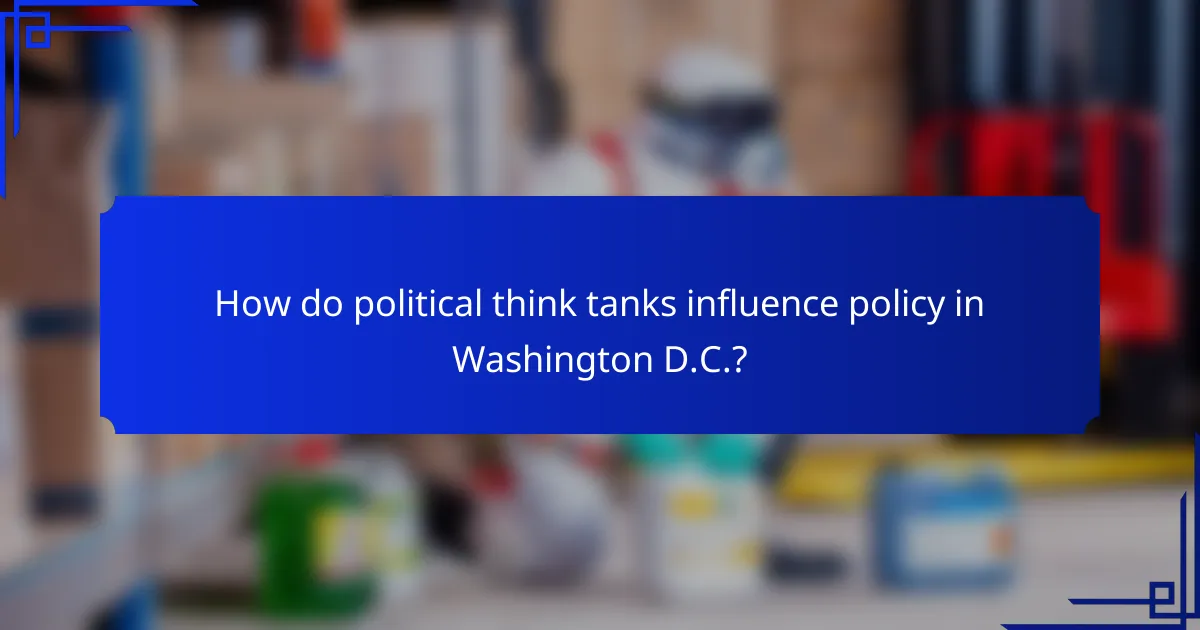Political think tanks play a crucial role in shaping policy by combining research, advocacy, and direct engagement with decision-makers. By employing effective strategies such as coalition building, social media outreach, and community engagement, these organizations enhance their influence and contribute to informed public discourse and legislative agendas.

How do political think tanks influence policy in Washington D.C.?
Political think tanks influence policy in Washington D.C. through a combination of research, advocacy, and direct engagement with policymakers. They provide data-driven insights and recommendations that shape legislative agendas and public discourse.
Direct lobbying efforts
Direct lobbying is a primary method through which think tanks influence policy. They engage with lawmakers and their staff to advocate for specific legislation or regulatory changes. This often involves presenting research findings, drafting policy proposals, and meeting with decision-makers to discuss the implications of certain policies.
Think tanks may also mobilize grassroots campaigns to demonstrate public support for their positions, which can further pressure legislators to act in alignment with their recommendations.
Research publications and reports
Research publications and reports are critical tools for think tanks to disseminate their findings and influence policy discussions. These documents often provide in-depth analysis, case studies, and data that support their policy recommendations. By publishing these reports, think tanks establish themselves as credible sources of information.
Many think tanks also produce policy briefs that summarize key findings in a more accessible format, making it easier for policymakers and the public to understand complex issues.
Partnerships with government agencies
Partnerships with government agencies enhance the credibility and reach of think tanks. By collaborating on research projects or policy initiatives, think tanks can directly contribute to the development of public policy. These partnerships often involve joint studies, workshops, or advisory roles.
Such collaborations can lead to the implementation of evidence-based policies that reflect the insights provided by think tanks, thereby increasing their impact on governance.
Public engagement initiatives
Public engagement initiatives are essential for think tanks to raise awareness and foster dialogue around key policy issues. These initiatives can include public forums, seminars, and community outreach programs designed to educate citizens and encourage participation in the policymaking process.
By engaging the public, think tanks can build a broader base of support for their policy positions, which can influence lawmakers to consider public opinion when making decisions.
Media outreach and commentary
Media outreach is a vital strategy for think tanks to shape public discourse and policy narratives. By providing expert commentary and analysis to journalists, think tanks can ensure their perspectives are included in news coverage. This visibility helps to frame issues in a way that aligns with their policy goals.
Additionally, think tanks often utilize social media platforms to amplify their messages and engage with a wider audience, further enhancing their influence on public opinion and policy debates.

What engagement strategies are effective for think tanks?
Effective engagement strategies for think tanks include building coalitions, utilizing social media, hosting public forums, and leveraging data analytics. These approaches enhance policy influence and foster collaboration with stakeholders.
Building coalitions with stakeholders
Building coalitions involves forming partnerships with various stakeholders, including government agencies, non-profits, and private sector organizations. This collaborative approach can amplify a think tank’s influence and reach, creating a united front for policy advocacy.
To effectively build coalitions, identify common goals and shared interests among stakeholders. Regular communication and joint initiatives can strengthen these relationships, ensuring sustained engagement and support.
Utilizing social media platforms
Social media platforms are essential tools for think tanks to disseminate research and engage with a broader audience. By sharing insights and updates on platforms like Twitter, LinkedIn, and Facebook, think tanks can enhance their visibility and foster discussions around key issues.
To maximize impact, tailor content for each platform and engage actively with followers. Use visuals, infographics, and short videos to convey complex ideas quickly and effectively, encouraging shares and interactions.
Hosting public forums and discussions
Hosting public forums and discussions allows think tanks to engage directly with the community and policymakers. These events can facilitate dialogue, gather diverse perspectives, and raise awareness about critical issues.
Consider organizing panels with experts and stakeholders to discuss relevant topics. Ensure that forums are accessible, both in-person and online, to reach a wider audience and encourage participation from various demographics.
Leveraging data analytics for outreach
Data analytics can significantly enhance outreach efforts for think tanks by providing insights into audience behavior and preferences. By analyzing engagement metrics, think tanks can refine their strategies and tailor content to better resonate with their target audiences.
Utilize tools that track social media interactions, website traffic, and survey responses. This data can inform decisions on which topics to prioritize and how to engage different segments of the audience effectively, maximizing overall impact.

What are the best practices for think tanks in the UK?
Best practices for think tanks in the UK include fostering collaboration with academic institutions, engaging local communities, and advocating for policy changes through grassroots movements. These strategies enhance their influence and effectiveness in shaping public policy.
Collaborative research with universities
Collaborating with universities allows think tanks to leverage academic expertise and resources, leading to more robust research outcomes. This partnership can involve joint studies, access to data, and shared funding opportunities, enhancing credibility and outreach.
Think tanks should seek to establish formal agreements with universities, such as research contracts or co-hosted events. This can help in aligning research agendas and ensuring that findings are disseminated effectively to policymakers and the public.
Engagement with local communities
Engaging with local communities is crucial for think tanks to ensure their research addresses real-world issues. This can involve hosting public forums, workshops, and surveys to gather input and feedback from community members.
Think tanks should prioritize building relationships with community leaders and organizations. This grassroots approach not only improves the relevance of their work but also fosters trust and support among the public, which can be vital for policy influence.
Policy advocacy through grassroots movements
Policy advocacy through grassroots movements enables think tanks to mobilize public support for specific issues. By organizing campaigns and leveraging social media, they can raise awareness and encourage civic participation in policy discussions.
Effective grassroots advocacy often includes clear messaging, coalition-building with other organizations, and strategic use of local events to amplify their voice. Think tanks should focus on creating actionable steps for community members to engage with policymakers, such as petitions or public meetings.

How do think tanks measure their impact?
Think tanks measure their impact through various methods, including tracking policy changes, assessing shifts in public opinion, and evaluating media coverage. These approaches help determine how effectively they influence policy and public discourse.
Tracking policy changes influenced
One primary way think tanks measure their impact is by tracking changes in legislation or policy that align with their research and recommendations. This involves monitoring government actions, legislative proposals, and executive orders to see if they reflect the think tank’s influence.
For instance, a think tank advocating for environmental policy might analyze whether new regulations on carbon emissions have been implemented following their reports. They may also compare the timing of their publications with policy announcements to establish a correlation.
Assessing public opinion shifts
Think tanks often conduct surveys and polls to gauge public opinion before and after their campaigns or publications. By comparing data over time, they can identify whether their messaging has resonated with the public and influenced perceptions on key issues.
For example, if a think tank releases a study on healthcare reform, they might measure changes in public support for specific policies through follow-up surveys. Tracking these shifts helps them understand their effectiveness in shaping public discourse.
Evaluating media coverage and mentions
Media coverage serves as another critical metric for assessing a think tank’s impact. By analyzing the frequency and context of mentions in news articles, broadcasts, and online platforms, think tanks can evaluate how their ideas are being disseminated and discussed in the public sphere.
They can use media monitoring tools to track coverage related to their research topics. A notable increase in mentions, particularly in reputable outlets, can indicate successful engagement with the media and, by extension, the public. This analysis helps refine future communication strategies.
